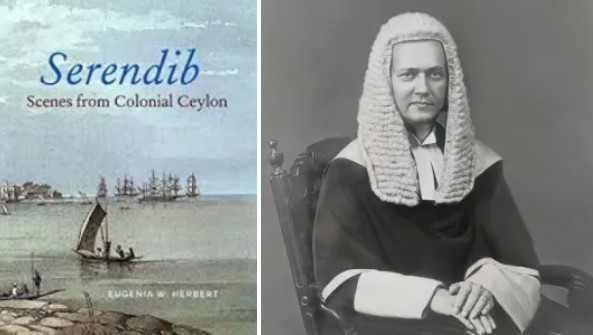Percy Colin-Thomé and the Composition of the Book People Inbetween-by Michael Roberts

Source:Thuppahis
Percy Colin-Thomé was born in Galle and his initial learning roots were at Richmond College. His genealogical roots derived from the Swiss personnel of the de Meuron Regiment in the service of the VOC in the 1790s who stayed on in Sri Lanka in British times when the colonial lands on the coast of Ceilao were taken over by the expanding imperial power known as Britain. These lineages became one strand in the mixed/race “Burgher” ethnic group in the island once the whole arena had been unified as colony by Britain between 1815 and 1818. Largely urban in background and increasingly English-speaking at home, these Burgher people became an influential segment of the local “middle-class” fulfilling intermediary roles in the British colonial service.[1]
Calverley House verandah in Cinamon Gardens in the 20th century — an epitome of middle class life styles
As such, there was a significant concentration of Burghers in the City of Colombo and this metropolis was where Percy Colin-Thome set up house. Apart from his professional engagements in the legal field, Percy was prominent in the Thespian Society of actors and served as President of the Dutch Burgher Union from 1988-98. I cannot recall how and precisely when our paths crossed in ways that led to our collegial interaction in the manuscript that eventually appeared in print in 1989 under the imprint of Sarvodaya Book Publishing House with the title People Inbetween (the incorrect form of “inbetween” being my imposition — because I consider it more aesthetic).
Roberts in the 1980s
This particular outcome of a collaborative enterprise involving Percy, Ismeth and myself cannot be understood without a digression that focuses on my career and the research work pursued in the 1980s. After I received an appointment at the Dept of Anthropology at the University of Adelaide in 1977 my disciplinary training was perforce expanded into sociological and anthropological realms. My appointment was probably directed by an ambitious scheme to study the development of Colombo in a multi-disciplinary manner – a project developed by Professor Bruce Kapferer and Dr. Kingsley Garbett. Adelaide University’s long vacation extended from November through to the end of January, so one aspect of this project was a detailed survey of the socio-economic and migration details of households in Colombo city via a survey of cross-sections conducted by a troupe of local personnel administering questionnaires. In 1978/79 Garbett directed this enterprise with me in support (presumably because of my local contacts and knowledge). Kapferer, Garbett, Lee Sackett and Roberts complemented this background statistical work with their own urban studies after year-long stints of research in the city in the following years.
My year’s turn came at the end of 1980 – so that the Roberts family (Shona, Kim Maya and myself) found a house to rent in Nugegoda in December 1980 and settled down to live there for a year. My focus was ethnographic work on (A) the shanty area in Kirulapona (B) the motor trading shops at Panchikawatte Rd, Maradana[2] and its successful merchant princes and (C) the historical transformation of the city of Colombo from the 1800s onwards.
The third line of inquiry, the growth of Colombo, led to of the material that is encompassed in People Inbetween. It also led me to visit the records office of the Colombo Museum, the Department of National Archives and the Library of the Ceylon Branch of the Royal Asiatic Society (then located in the Old Racecourse buildings). It was at the latter site that I banged into Jehan Raheem – once a fellow student and rugby mate at Ramanathan Hall. This chance event brought me into contact with his younger brother Ismeth, an architect and book collector with an avid interest in the island’s history. The RAS library was (and still is) the repository of the CA Lorenz Manuscripts – all locked away in a solid cabinet.[3]
These documents – including copies of letter written as well as a variety of printed articles from the mid-nineteenth century – are a goldmine. In plunging into this work, I recruited the help of Percy Colin-Thome (a friend of my elder sister Sheila and Rene Ludowyk[4]). The friendship between Percy, Ismeth and myself flowered from that point on. My memory is defective, but I think most of the work that went into the book People Inbetween was pursued in the years 1986/87 when I had another sabbatical year of research involving a long stay in Colombo and Sri Lanka.
As originally planned, People Inbetween was meant to extend into four volumes. Ismeth Raheem served as the ‘General’ pursuing his expertise in historical portraiture and architecture to produce the second volume Images of British Ceylon in 2000 (Times Edition, Singapore). Percy, alas, had passed away be then. Volumes III and IV have not seen the printer’s ink. This scheme sought to present the letters and work of Charles Ambrose Lorenz and his circle as well as a collection of writings, paintings, drawings and photographs from a talented pool of personnel – mostly Burgher but including a few Sinhalese and some Europeans (e. g. the Worms brothers).[5]
This failure is to be regretted.
C’est la vie.
**** ****
APPENDIX: Original Intentions that did not see fruition
Volume III: People Inbetween: Life and Times in British Ceylon, 1840-70
I-III: Letters (being copies of original letters from JF Lorenz Snr, Alfred Drieberg, C. A. Lorenz and Lily Bartholomeusz)
IV: Materials, Culture and the Social Scene
V: Selections from Nineteenth Century Paintings
VI: J. L. K. Van Dort’s Pencil and Brush
Volume IV: Life and Times in British Ceylon, 1840-70
VII: Views of Ceylon c.1868: The Worms Collection
VIII: Perakadoru, The Proctor’s Paradise
IX: Events and Incidents
X: Orientations and Incidents










